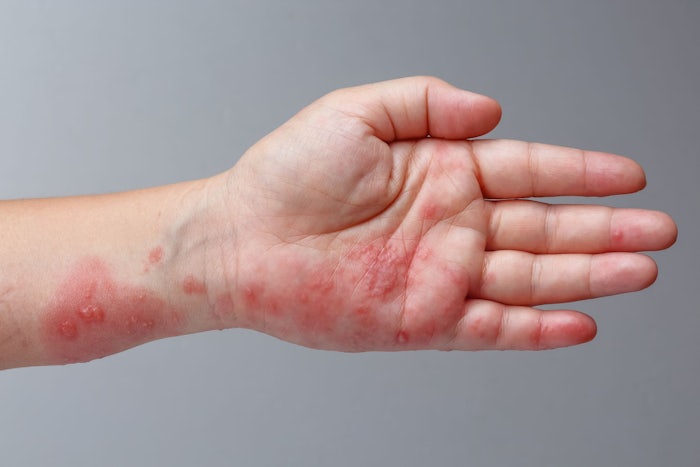A guide to shingles for older Australians
Pain, sunburn or the re-activation of chickenpox after years of dormant infection? This edition of Aged Care Guide covers all you need to know about the painful condition.
- Jump To Section:
- Shingles and ageing •
- Treatment of shingles •
- Important facts about shingles

Once a person gets the chickenpox virus, the condition may lay dormant and flare-up later in life in the form of shingles. (Source: Shutterstock)
Key points:
- Almost every adult 50 years and older already carries the inactive virus that causes shingles later in life
- Over 70 percent of shingles cases occur in people aged over 50 years
- Despite how healthy a person may feel, approximately one-in-three people will experience the condition in their lifetime
This edition of Aged Care Guide covers shingles in older Australians. This article will address the prevalence of shingles (herpes zoster virus) in ageing populations, along with symptoms, treatment and general knowledge tidbits which are relevant to the condition.
Chickenpox (varicella) is highly contagious, although an ultimately mild, viral infection which tends to impact people more severely as they age. The relative age and severity of the infected party has prompted some instances of ‘chickenpox parties’ or simply ‘pox parties,’ wherein parents encourage their children to interact and ultimately acquire the infection in order to prevent potential vulnerability later in life. Medical professionals and paediatricians often discourage the practice, which some mistakenly believe is conducive to promoting immunity, instead, authorities suggest that people receive a vaccination for better outcomes.
Shingles and ageing
Symptoms of shingles may include:
- Nausea, upset stomach
- Chills
- Headaches
- Blistering rashes accompanied by itching, discomfort and tingling — onset may begin 48 – 72 hours prior to visible skin blistering
Shingles may make a person feel incapable of managing day-to-day tasks without intermittent and shocking pain. The condition does not typically last for longer than a month, with symptoms improving over the course of two – four weeks.
The likelihood of a recurrent shingles episode is approximately five percent, meaning that many who experience the condition will be unlikely to face a similar episode, unless their immune symptom is notably compromised. However, as people age, a diminished immune system may heighten the risk of subsequent shingles episodes.
Those who experience shingles are considered to be infectious for up to a week after visible skin lesions appear and seem ‘moist,’ according to the Victorian Department of Health.
Treatment of shingles
Antiviral treatments (ie. creams, lotions and topical ointments) may reduce the severity and longevity of visible symptoms, along with minimising the risk of long-term complications resulting from a shingles episode. Complications may include:
- Facial paralysis
- Brain inflammation
- Visual impairment
- Postherpetic neuralgia — impacting a fifth of people who experience shingles, leading to ongoing pain despite visible improvement of symptoms
Treatment options for managing the symptoms of pain caused by shingles may include anticonvulsant medicines, over-the-counter painkillers, topical cooling medications and prescription pain relief — such as synthetic opiate treatments or opitate-derived medications. Blistering and open wounds that develop as a result of raised or tactile bumps on the skin tend to crust and heal after seven to 10 days.
It is generally recommended to see a general practitioner (GP) or relevant specialist to inform them of a shingles episode or suspected onset in order to handle pain management, advise potential care options and discuss the likelihood of a second occurrence based on overall immunity. Contributing factors to a weakened immune system, which may leave the door open for a second episode, include:
- Being 50+
- Obesity, diabetes, physical injury or a strained immune system
- Diagnosis of an immunocompromising condition — with human immunodeficiency virus (HIV) or acquired immunodeficiency syndrome (AIDS) critically impacting the body’s ability to defend itself
- Immense feelings of stress
- Avoidance of or ineligibility for the chickenpox virus vaccine
Important facts about shingles
Myth: shingles is seasonal
Fact: Although it is commonly believed that shingles flare-ups may occur seasonally or in a manner similar to an epidemic, the only related factors which contribute to a potential onset of shingles are: a prior episode of chickenpox, stress, age and immunodeficiency.
Myth: shingles isn’t infectious
Fact: Although chickenpox is widely regarded as a greater infection risk to others in the vicinity, the fluid-filled blisters which arise during shingles episodes may transmit the disease to others. It is important to practise proper hygiene and inform health professionals should they make contact with someone who is experiencing shingles.
Myth: shingles is the same thing as chicken pox
Fact: Despite chickenpox introducing the body to shingles later in life, the two viruses are not the same thing. If you were to scrape your knee and begin bleeding, but the wound becomes infected over time — scraping your need would not necessarily be the cause of the infection. Similarly, chickenpox leaves the door open for the herpes zoster virus to travel through the spinal cord and set up camp in the brain, where it can become ‘reactivated’ later in life in a separate way.



![Keeping healthy and fit can help stave off a lot of chronic health problems that tend to pop up as you age. [Source: Shutterstock]](https://agedcareguide-assets.imgix.net/news/articles/wp/12_11_2021-Top-health-concerns.jpg?fm=pjpg&w=162&h=124&q=80)
![Why is falling so much more serious when we get older? [Source: Shutterstock]](https://agedcareguide-assets.imgix.net/news/articles/wp/oldwimnfell__2103.jpg?fm=pjpg&w=162&h=124&q=80)

![If you’re after government-funded support, you’ll need to be assessed. [Source: iStock]](https://agedcareguide-assets.imgix.net/news/articles/wp/ACATACAS__3010.jpg?fm=pjpg&w=162&h=124&q=80)
![Learning about how much it may cost you to receive aged care will help you to refine your fiscal planning. [Source: iStock]](https://agedcareguide-assets.imgix.net/news/articles/wp/nursinghomecosts__111.jpg?fm=pjpg&w=162&h=124&q=80)


